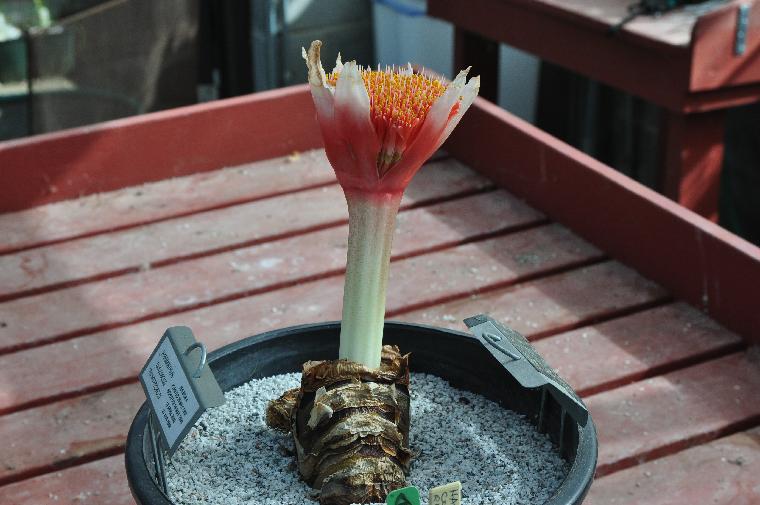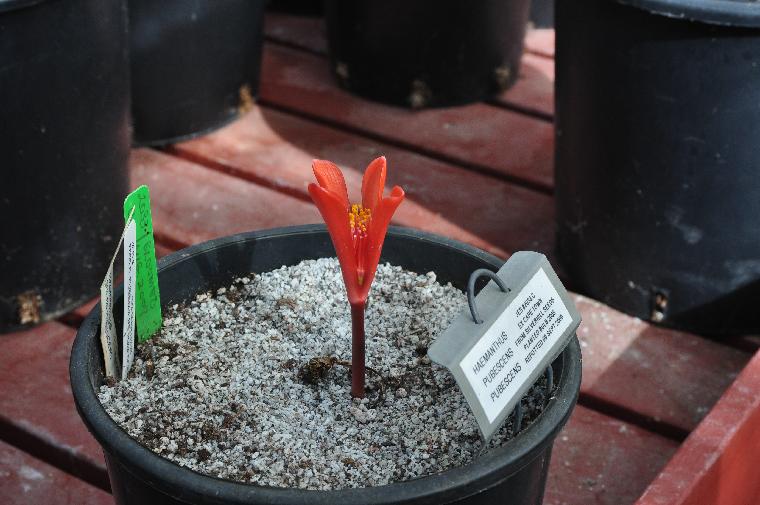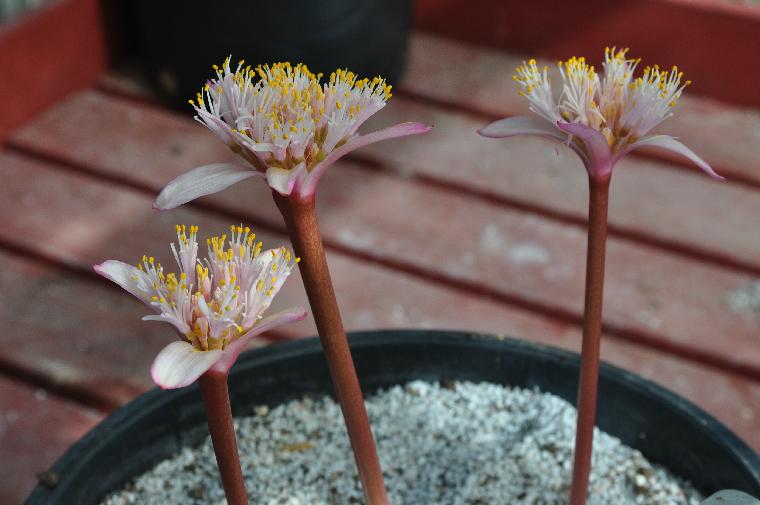Unique Haemanthus coccineus
This one has bloomed a couple of weeks ahead of all the other coccineus the last couple of years. This year, the heat when it tried to bloom seems to have affected the coloration of the bracts. I find this oddball bloom very attractive; I just wish it would do it every year!

Haemanthus coccineus with Bicolor Bracts
I think this bicolor pattern is a thermal effect. It was very hot when this scape started trying to emerge. It was stuck half-way out of the bulb for a couple of weeks at least, and I think this was, while the hidden parts of the bracts developed the normal scarlet coloration.
Haemanthus pubescens pubescens
These bulbs came out of Rod and Rachel Saunders' yard near Cape Town. This is the first time they have bloomed. Since this is a first bloom, I expect the inflorescence to become a bit bigger in future years. The bulbs were decent sized when I received them, but they suffered several years trying to adjust to the change of hemispheres, so it has taken over 5 years for them to flower here.

Haemanthus pubescens pubescens, First Bloom
The blooms typically have 4 or 5 stout, fleshy bracts, sometimes as many as 7. The flowers are overshadowed by the longer bracts. Snijman (1984) recognized three subspecies: pubescens, leipoldtii, and arenicolus. The latter two are quite rare.
Haemanthus barkerae
Haemanthus barkerae is a member of a group of closely related species including crispus and tristis which have similar bulb structures and inflorescences. Snijman also groups namaquensis with these three species, but I have my doubts about this one. A good dose of DNA sequencing appears to be called for to sort these out. In any case, all four of these species are found only in Namaqualand and the western Karoo. Crispus has a small bright scarlet inflorescence on a very short stem; namaquensis has a large scarlet bloom that looks much like coccineus; tristus and barkerae both have light pink bracts and flowers. I still lack tristis, unfortunately; it's quite rare and possibly endangered.

Haemanthus barkerae
H. barkerae has a limited range, but still varies in leaf shape from north to south in that restricted area. I'm surprised someone hasn't split the different populations into two or three separate species. Perhaps no one dares challenge the formidable Dr. Snijman!
Haemanthus [barkerae x coccineus]
This is a cross I made myself. The resulting inflorescence is pretty close to an average between the two parental species insofar as the size and shape are concerned. The leaves tend to be examples of hybrid vigor in some cases, with the form of the barkerae leaves but much larger. They also started blooming in only 4 or 5 years instead of the 7 to 10 years their parental species take from seed to flowering -- more hybrid vigor.
![Haemanthus [barkerae x coccineus] (c) copyright 2010 by Shields Gardens Ltd. All rights reserved.](Haemanthus_barkerae_x_coccineus_Nr2069A_0407_ml.jpg)
Haemanthus [barkerae x coccineus]
In making this cross, I had hoped to get some of the pink color of the barkerae with the larger form of the coccineus inflorescence. So far, those hybrids that have bloomed all have form like over-sized barkerae and the scarlet color of coccineus. I judge the color pink to be recessive in the crispus group of species.
Good gardening, from here in central Indiana
Jim
Look up technical terms in the Glossary of Plant Biology